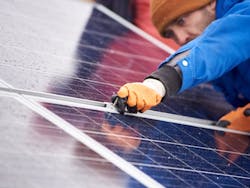Clean Energy Stimulus Spending Could Jump Start Growth, Report Finds
With Congress eyeing another coronavirus economic package, a new report finds that federal economic stimulus spending on clean energy, including microgrids, electric vehicles and energy storage, could jump start a surge in economic growth.
So far, the clean energy sector has been left out of the federal COVID-19 stimulus, but an incoming Joe Biden administration could change that dynamic.
The coronavirus crisis destroyed millions of American jobs, including hundreds of thousands in clean energy, the Biden-Harris transition team said on its transition website that went live Monday. One of President-elect Biden’s top four priorities is tackling climate change, which includes investing in zero emission vehicles, renewable energy and building upgrades, according to the website.
Investments in a range of advanced energy technologies and services would lead to economic benefits that are four to 14 times as high as the spending, according to an analysis prepared for Advanced Energy Economy and Texas Advanced Energy Business Alliance.
In California, a $100 billion injection of federal funds would add $727 billion to California’s gross state product, according to a report drafted by the Analysis Group, an economic consulting firm.
Clean energy stimulus spending in 8 states
The reports examined what would happen in eight states if $2 trillion was spent nationwide on clean energy initiatives. The states were Arizona, California, Colorado, Florida, Illinois, Nevada, Pennsylvania, and Texas. The Analysis Group prepared reports for each state based on a spending allocation that mirrored stimulus programs following the 2008-2009 financial crisis.
The study, released Oct. 29, focused on the economic effects of spending on grid modernization, including smart meters and microgrids, solar and wind generation; energy efficiency; energy storage; electric vehicles and charging infrastructure; and transmission upgrades.
The Analysis Group found that in all states studied the greatest economic impact comes from investing in energy efficiency, which was allocated a quarter of all the stimulus spending. In California, for example, $20 billion in spending on energy efficiency produced $373 billion in additional gross state product growth and 1.9 million job-years.
Solar and wind energy made up the next largest section of investment and growth across the states, according to the report. The Analysis Group assumed solar would get 20% of all the federal spending and wind would get 10%.
In Texas, $11 billion and $5.5 billion in spending on solar and wind, respectively, would boost gross state product by $51 billion of $14 billion, the Analysis Group found.
Electric vehicles and charging infrastructure spending — assumed to total 20% of overall investments — could spur growth in states, the Analysis Group found. In Illinois, $9 billion in sounding on EV incentives and subsidies would increase the state’s gross product by $30 billion while adding 240,000 job years, the report said.
Grid modernization funding spurs growth
With 5% of total spending, the Analysis Group found that investment in grid modernization provided a range of benefits.
The consulting firm said grid modernization investments could include technologies, products, and software development for residential and commercial energy management, microgrid management and other improvements in the efficiency of the distribution system.
In California, a $5 billion investment in grid modernization would increase the state’s gross product by $12 billion and add 108,000 job years.
In Texas, $2.8 billion in grid modernization would boost state gross product by $6 billion and add 69,000 job years.
In Illinois, $2.25 billion in grid modernization spending would boost state gross product by $5 billion and job years by 54,000.
Track news about federal stimulus and microgrids. Subscribe to the free Microgrid Knowledge newsletter.
